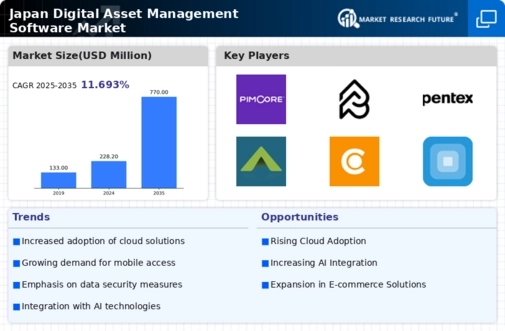Emergence of Industry-Specific Solutions
The digital asset-management-software market is experiencing a notable emergence of industry-specific solutions tailored to meet the unique needs of various sectors in Japan. As organizations recognize that one-size-fits-all approaches may not suffice, there is a growing demand for software that addresses specific challenges faced by industries such as healthcare, retail, and entertainment. In 2025, it is anticipated that 40% of businesses will seek customized digital asset-management solutions that align with their operational requirements. This trend suggests a shift towards more specialized offerings, enabling organizations to optimize their asset management processes. The emergence of industry-specific solutions is likely to enhance the competitiveness of the digital asset-management-software market, as vendors strive to provide tailored functionalities that resonate with the distinct needs of different sectors.
Growing Need for Remote Collaboration Tools
The digital asset-management-software market in Japan is witnessing a growing need for remote collaboration tools, particularly as organizations adapt to evolving work environments. The shift towards remote and hybrid work models has necessitated the development of software that facilitates seamless collaboration among teams, regardless of their physical location. In 2025, it is projected that 60% of companies will prioritize digital asset-management solutions that offer collaborative features, such as real-time editing and sharing capabilities. This trend indicates a significant transformation in how organizations manage their digital assets, as they seek to enhance teamwork and communication. The demand for remote collaboration tools is likely to drive innovation within the digital asset-management-software market, prompting vendors to develop solutions that cater to the needs of distributed teams and improve overall efficiency.
Rising Demand for Digital Content Management
The digital asset-management-software market in Japan experiences a notable surge in demand for efficient digital content management solutions. As businesses increasingly rely on digital assets for marketing and branding, the need for robust management tools becomes paramount. In 2025, the market is projected to grow at a CAGR of 12%, driven by the necessity for organizations to streamline their workflows and enhance collaboration. Companies are seeking solutions that not only store assets but also facilitate easy retrieval and sharing, thereby improving productivity. This trend indicates a shift towards comprehensive platforms that integrate various functionalities, catering to the diverse needs of businesses across sectors. The rising demand for digital content management solutions is likely to propel the growth of the digital asset-management-software market in Japan, as organizations prioritize efficiency and effectiveness in their operations.
Increased Focus on Data Security and Compliance
In the context of the digital asset-management-software market, the emphasis on data security and compliance is becoming increasingly critical for organizations in Japan. With the rise of data breaches and stringent regulations, companies are compelled to adopt solutions that ensure the protection of their digital assets. The market is witnessing a shift towards software that incorporates advanced security features, such as encryption and access controls, to safeguard sensitive information. In 2025, it is estimated that 70% of organizations will prioritize compliance with data protection regulations, influencing their choice of digital asset-management solutions. This heightened focus on security not only mitigates risks but also enhances trust among stakeholders, thereby driving the adoption of sophisticated digital asset-management software. Consequently, the digital asset-management-software market is likely to expand as businesses seek to align their operations with regulatory requirements and protect their valuable digital assets.
Advancements in User Experience and Interface Design
In the digital asset-management-software market, advancements in user experience (UX) and interface design are becoming increasingly pivotal for attracting and retaining customers in Japan. As organizations prioritize usability, software providers are focusing on creating intuitive interfaces that enhance user engagement and satisfaction. In 2025, it is projected that 75% of users will prefer solutions that offer streamlined navigation and visually appealing designs. This emphasis on UX indicates a broader trend towards user-centric software development, where the ease of use directly influences adoption rates. Consequently, the digital asset-management-software market is likely to see a rise in demand for solutions that not only meet functional requirements but also provide an enjoyable user experience, thereby fostering loyalty and long-term relationships with clients.






















Leave a Comment